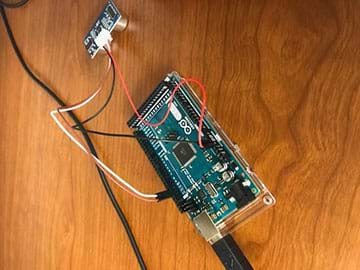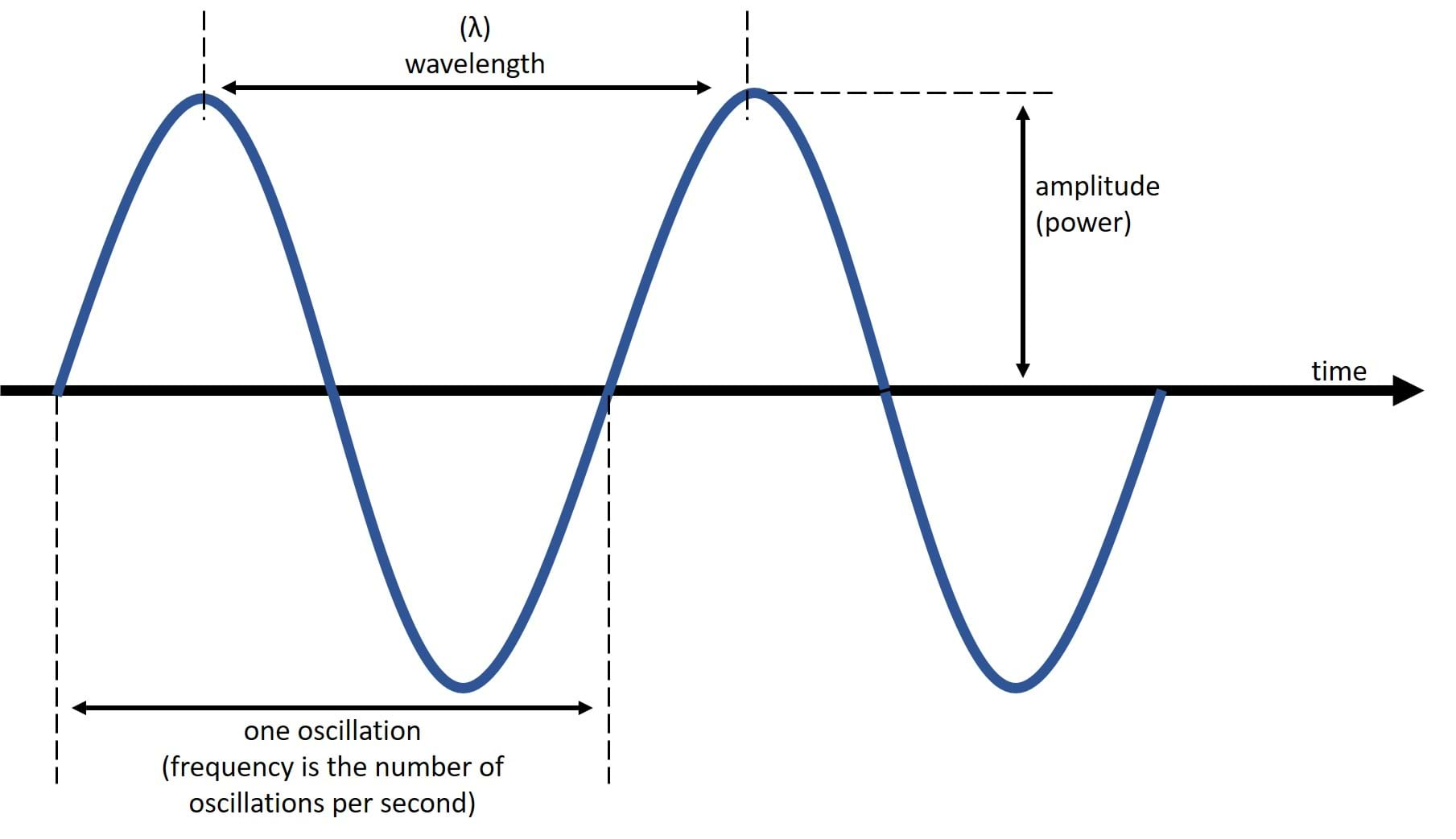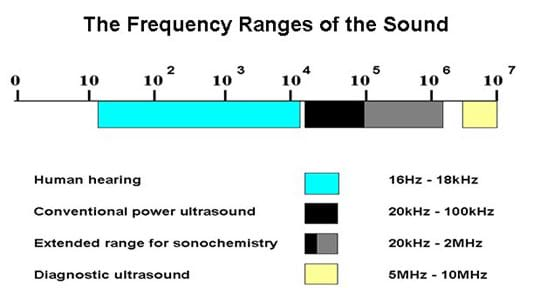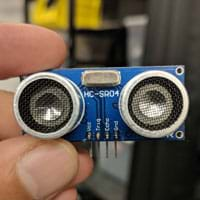Quick Look
Grade Level: 6 (6-8)
Time Required: 45 minutes
Lesson Dependency: None
Subject Areas: Computer Science, Measurement, Physics, Science and Technology

Summary
This lesson focuses on ultrasound wavelengths and how sound frequencies are used by engineers to help with detection of specific distances to or in materials. Students gain an understanding about how ultrasonic waves are reflected and refracted. Students also see how ultrasound technology is used in medical devices. The activity following this lesson allows students to test their knowledge by using the Sunfounder Ultrasonic sensor and Arduino Mega Microcontroller.Engineering Connection
Biomedical engineers design devices that allow physicians to use ultrasound imaging to view inside the body. Ultrasound images and videos are captured in real time and can provide details about movement of organs as well as blood flow in a noninvasive way. Ultrasound imaging does not expose individuals to ionizing radiation the way X-ray imaging does.
Electrical, mechanical, and computer engineers often use ultrasonic devices to measure and evaluate materials used in manufacturing and building to identify potential defects without destroying the product. By allowing engineers to essentially look inside a structure, ultrasonic devices also provide means for safely inspecting power plants, nuclear reactors, oil pipelines, and electric wirings and can isolate the area of concern. This is a much safer and efficient approach than older scanning methods.
Learning Objectives
After this lesson, students should be able to:
- Identify a way ultrasound is used to help us in everyday life
- Explain why there are different ways to measure with ultrasonic devices
- Explain how an ultrasonic distance sensor measures distance
Educational Standards
Each TeachEngineering lesson or activity is correlated to one or more K-12 science,
technology, engineering or math (STEM) educational standards.
All 100,000+ K-12 STEM standards covered in TeachEngineering are collected, maintained and packaged by the Achievement Standards Network (ASN),
a project of D2L (www.achievementstandards.org).
In the ASN, standards are hierarchically structured: first by source; e.g., by state; within source by type; e.g., science or mathematics;
within type by subtype, then by grade, etc.
Each TeachEngineering lesson or activity is correlated to one or more K-12 science, technology, engineering or math (STEM) educational standards.
All 100,000+ K-12 STEM standards covered in TeachEngineering are collected, maintained and packaged by the Achievement Standards Network (ASN), a project of D2L (www.achievementstandards.org).
In the ASN, standards are hierarchically structured: first by source; e.g., by state; within source by type; e.g., science or mathematics; within type by subtype, then by grade, etc.
NGSS: Next Generation Science Standards - Science
-
CCC.5.6-8.6.
Energy may take different forms (e.g. energy in fields, thermal energy, energy of motion).
(Grades 6 - 8)
More Details
Do you agree with this alignment?
-
DCI.PS4.A.6-8.5.
A sound wave needs a medium through which it is transmitted.
(Grades 6 - 8)
More Details
Do you agree with this alignment?
Common Core State Standards - English
-
Cite specific textual evidence to support analysis of science and technical texts.
(Grades
6 -
8)
More Details
Do you agree with this alignment?
International Technology and Engineering Educators Association - Technology
-
Students will develop an understanding of the characteristics and scope of technology.
(Grades
K -
12)
More Details
Do you agree with this alignment?
-
Students will develop an understanding of the relationships among technologies and the connections between technology and other fields of study.
(Grades
K -
12)
More Details
Do you agree with this alignment?
-
Advances and innovations in medical technologies are used to improve healthcare.
(Grades
6 -
8)
More Details
Do you agree with this alignment?
-
Develop innovative products and systems that solve problems and extend capabilities based on individual or collective needs and wants.
(Grades
6 -
8)
More Details
Do you agree with this alignment?
Worksheets and Attachments
Visit [www.teachengineering.org/lessons/view/mis-2227-ultrasonics-uses-arduino-ultrasound-technology] to print or download.Pre-Req Knowledge
Students should have a basic knowledge from 4th grade of how energy is transferred through a medium. If needed you could teach the lesson, What Is Energy?
Introduction/Motivation
When we think of the nature of sound, what comes to mind—or, to the ear perhaps? Is it the sound a dog makes while barking, a television with the volume turned up, music inside a car—or even the hum of traffic outside it? Our ability to hear is because our ears are designed to detect vibrations made by sound waves. Sound is simply the movement of energy as vibrations that travel through solids, liquids, or gases.
When these vibrations move through air they disturb it causing it to expand and contract. Sound also can bounce off objects, changing the direction and strength of the vibrations. There are some sounds, however, that we can’t hear. Infrasound, or low-frequency sound, does not have enough sound pressure to be detected by our ear. Ultrasound—which we will discuss more throughout this lesson—is also undetectable because of the limitations of our ear. In order to understand how ultrasound works, let’s take a look at some of the parts of a sound wave as seen in Figure 1.
- The wavelength represents variation in air pressure and is the distance over which the wave’s shape repeats.
- An oscillation of a wave is defined how long it takes for a wave to move from starting position, one position to the next and back to the start.
- Amplitude refers to the intensity or power of the sound wave, and relates to volume.
- The frequency of a wave is defined as number of oscillations the wave completes in a certain amount of time (usually seconds)
- The unit of measurement for sound is a hertz (Hz), and it is based on how many oscillations occur per second.

Now that we know about the basics of sound and sound waves, do we know if it’s possible to see sound? We can see the properties of sound on a graph, but can we actually see it with our eyes? To test this, we are going to watch some videos where you can see sound. Observe the videos, think about the connection between the sound and what you see.
[Show the students a video that allows students to see sound waves. Here are the top 3 choices]
Sound Looking: https://www.youtube.com/watch?v=XBP0jmpjzBw&t=32s
Rubens' Flame Tube: Seeing Sound Through Fire: https://www.youtube.com/watch?v=pWekXMZJ2zM
Portland Rubens' Tube - Music Trials: https://www.youtube.com/watch?v=gpCquUWqaYw
(After the video, give students a minute to share with a partner what they observed in the video where the sound waves created movement with the material and/or what questions they have.)
Use Readworks Online or Readworks printed articles at Readworks.org. These are suggestions to try to connect to reading comprehension at different levels. Readworks is free to educators and offers online reading and quizzing options.
Titles include:
- What is Sound?
- Sound Waves
- The Human Voice
- Sound’s Loudness
- Alexander Graham Bell’s inspiration
(After students read an article on sound from Readworks, have them complete the Reading and Reflection Worksheet)
Lesson Background and Concepts for Teachers
This lesson is designed to engage students in an understanding of how ultrasonic sound is useful to us. It explains what ultrasonic devices are and gives examples of its uses. It also specifically shows the Sunfounder HC-SR04 ultrasonic distance sensor. This lesson is connected to the associated activity Designing and Packaging a Distance-Sensing Product - where students use web editing software with the Sunfounder HC-SR04 distance sensor and Arduino Mega Microcontroller, Designing and Packaging a Distance Sensing Product.
One item that will come up in the lesson is the range of sounds. It would be helpful to understand powers of 10 as shown in Figure 2. When students look at the visuals of the frequency range of sound, they might not see how large the difference is.

Prior to presenting the Uses of Ultrasonic Sensors PowerPoint Presentation to students, it might be helpful to have the Arduino Mega 2560 with Sunfounder HC SR04 connected. To have students feel more comfortable with the Arduino Create Web Editor, open Arduino Create to toggle back and forth to during your slides. Refer to the activity, Designing and Packaging a Distance Sensing Product, for more detail on Arduino and Sunfounder hardware and software. At the bottom of each slide are notes that detail how to discuss the slide with students. Notes will include what to say and additional information to give to students.
Outline of the slides:
Slide 1: Title
Slide 2: Launches lesson with a question to ponder
Slide 3: Gives students goals for the lesson
Slide 4: Defines Sound
Slide 5: Gives students needed vocabulary-oscillation, frequency, and hertz
Slide 6: Diagram of a wave
Slide 7: Diagram of sound spectrum
Slide 8: Description and examples of ultrasound
Slide 9: Description and examples of sound propagation
Slide 10: Description of transducers
Slide 11: Real world examples of ultrasound
Slide 12: Diagram of ultrasonic sensor and wave pattern
Slide 13: Explanation of why sensors are used
Slide 14: Wrap up
Associated Activities
- Designing and Packaging a Distance-Sensing Product - Students set up and learn how to use the Arduino Mega Microcontroller and Arduino Create Web Editor. Once students connect the Microcontroller and Sunfounder Ultrasonic sensor from the lesson, they will be able to measure distances with the sensor and see the distance output on either a netbook or computer. Once they have learned how the program works, they will work in teams to create a product that uses the sensors.
Lesson Closure
The last slide asks students to talk to a partner and discuss the four questions below.
- What is sound?
- What are the types of sound?
- Do all living things recognize the same sounds?
- How can ultrasound be used to help us in everyday life?
After students have time to discuss with partners, have groups share out what they discussed. To end the lesson, distribute the Uses of Ultrasound Technology Quiz to students.
Vocabulary/Definitions
amplitude: The intensity or power of the sound wave; relates to volume.
frequency: The number of oscillations a wave completes in a certain amount of time (usually seconds).
hertz: The unit of measurement (symbol: Hz) of sound, usually oscillations per second.
infrasound: Low frequency sound waves – too low for humans to hear. Animals are capable of sounds at these frequencies.
microcontroller: Mini processor coded to perform specific functions.
oscillation: How long it takes for a wave to move from starting position, one position to the next and back to the start.
sensor: An electronic device used to pick up and transmit information.
ultrasound: Sound waves traveling at too fast of a frequency for humans to hear.
wavelength: Variation in air pressure and the distance over which the wave’s shape repeats.
Assessment
Pre-Lesson Assessment
Initial Questions: Ask the probing questions in the Introduction/Motivation to begin the discussion of sound and how sound travels. It also gets students engaged in the topic of ultrasonic devices.
Post-Introduction Assessment
Reflection: Provide students with the Reading and Reflection Worksheet to complete after reading the article/informational text.
Lesson Summary Assessment
Quiz: Have students complete the Uses of Ultrasound Technology Quiz to gauge their understanding.
Homework
Reading: Through Newsela or ReadWorks, teachers have options of selecting information text(s) for students to read. Both offer free account options for teachers. The advantage with Newsela is getting an article at more than one level to allow for differentiation of student needs.
Some options from Newsela:
Lesson Extension Activities
Students could be given time to explore Arduino Create Project Hub. They could see some of the additional programming projects available.
Additional Multimedia Support
Video Segment: Read World Science: Sound; Measuring Sound (time 3:51)
Sound Vibrations Lesson: Many of the videos and activities within lesson would be helpful for gaining background knowledge about sounds for those students that struggle with prior learning concepts.
https://www.youtube.com/watch?v=XBP0jmpjzBw&t=32s
Subscribe
Get the inside scoop on all things TeachEngineering such as new site features, curriculum updates, video releases, and more by signing up for our newsletter!More Curriculum Like This

Students follow instructions to connect a Sunfounder Ultrasonic Sensor and an Arduino Microcontroller. Once they have them set up, students perform necessary calibrations, and practice using the sensor.

Students learn about the types of seismic waves produced by earthquakes and how they move through the Earth. Students learn how engineers build shake tables that simulate the ground motions of the Earth caused by seismic waves in order to test the seismic performance of buildings.

Students are introduced to sound energy concepts and how engineers use sound energy. Through hands-on activities and demonstrations, students examine how we know sound exists by listening to and seeing sound waves
Copyright
© 2018 by Regents of the University of Colorado; original © 2017 Michigan State UniversityContributors
Kendra RandolphSupporting Program
Smart Sensors and Sensing Systems RET, College of Engineering, Michigan State UniversityAcknowledgements
This curriculum was developed through the Smart Sensors and Sensing Systems research experience for teachers under National Science Foundation RET grant no. CNS 1609339. However, these contents do not necessarily represent the policies of the NSF, and you should not assume endorsement by the federal government.
Dr. Lalita Upda, Michigan State University College of Engineering, Non-Destructive Evaluation (NDE) Laboratory
Oleksii Karpenko (MS, Mechanical Engineering), Michigan State University, Non-Destructive Evaluation (NDE) Laboratory
Dr. Anders Rosell, Michigan State University College of Engineering, Non-Destructive Evaluation (NDE) Laboratory
Drew Kim, Michigan State University College of Engineering, RET Program Director
Last modified: December 22, 2021








User Comments & Tips